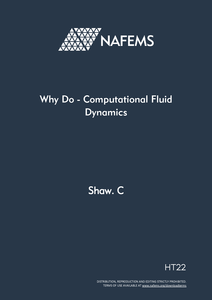
This book has been written with the objective of explaining to engineers and their managers, the benefits of using computational fluid dynamics (CFD) within engineering organisations. It is aimed at those who currently have little or no experience of CFD.
The principal aim of the book is to illustrate the potential advantages to be gained by using CFD and to persuade managers that acquisition of CFD technologies can be of great benefit to them in achieving their engineering objectives. Realistically there will be situations where the use of CFD might not always yield benefits, and the booklet attempts to provide a balanced and informed view in this respect.
The introduction sets the scene of increasing use of computer-based analysis technologies and CFD in particular, together with an outline of the structure used in the rest of the booklet. The potential benefits of adopting CFD are summarised in the form of a quick reference guide. A detailed explanation of the use of CFD to obtain solutions to real engineering problems then follows. This includes a look at the nature of design in its broadest sense and the activities needed to produce successful design solutions. From this background, the processes used to carry out modelling and analysis with CFD are placed in context.
The nature of fluid dynamics problems, in relation to the types of solutions sought by engineers, is then discussed. This is followed by a review of experimental methods used to investigate engineering situations involving fluid dynamics. The purpose of this section is to encourage readers to consider what can (and cannot) be measured experimentally. The technologies which have come together to allow CFD to be carried out, are reviewed, both in a historical context and in light of the present day capabilities, to realistically convey the current capabilities and limitations of CFD. In particular, given that experimental and computational methods are often seen as competing tools, comparisons are drawn between the two in the hope that the two methodologies might be seen as complementary rather than competing techniques.
It is intended through this analysis to further highlight how CFD can potentially deliver some or all of the following benefits to engineering organisations:
- Detailed Understanding of Product Performance,
- Rapid Evaluation of Design Alternatives & Optimisation of Performance,
- Reduction in Testing Costs,
- Reduction of Failure Risks,
- Reduction of Time to Market,
- Reduction of Incremental Development Risks,
- Improved Product Quality.
These benefits are achieved because CFD offers features not available through the use of alternative experimental methods.
- CFD provides a large amount of detail about a flow,
- CFD increases understanding of the physical flow problem,
- CFD allows for easy what-if testing,
- CFD does not require any large capital facility,
- CFD allows investigation where experimentation is not possible.
Although the numerical methods used within CFD can result in a complex set of mathematical equations, which can be difficult to solve, developments in CFD solvers and associated pre-/post-processing software, together with the massive increases in available computing resources, mean that CFD is finding ever increasing applications as a fast, accurate and cost-effective engineering tool working alongside more traditional experimental methods.
Contents
| 1 | Introduction | 1 |
| 2 | Benefits of Carrying Out CFD Analysis | 3 |
| 3 | The Design and Analysis Process | 5 |
| 3.1 | Design Situations | 5 |
| 3.2 | Design Processes and Activities | 5 |
| 3.3 | Computational Modelling in Design | 6 |
| 3.4 | Processes for Computational Analysis | 7 |
| 4 | Fluids in Motion | 9 |
| 4.1 | Some Rules of Motion | 9 |
| 4.2 | Categorising Fluid Flow Situations | 11 |
| 4.3 | Determining Solutions to Flow Problems | 12 |
| 5 | Experimental Methods | 13 |
| 6 | Computational Fluid Dynamics | 15 |
| 6.1 | The Role of Computer Hardware and Software Development | 15 |
| 6.2 | Forming a Numerical Analogue of the Governing Equations | 16 |
| 6.3 | Obtaining Solutions - Using CFD Algorithms | 17 |
| 6.4 | An Analysis Process for CFD | 18 |
| 7 | Comparing Experimental & Computational Methods | 21 |
| 8 | Conclusions | 23 |
| 9 | References | 25 |
| Appendix A | Experimental Methods | 27 |
| Case Study A | Fire in a Building | 31 |
| Case Study B | Automotive Examples | 33 |
| Case Study C | Flow in a Computer Housing | 37 |
| Case Study D | Valve Design | 41 |



